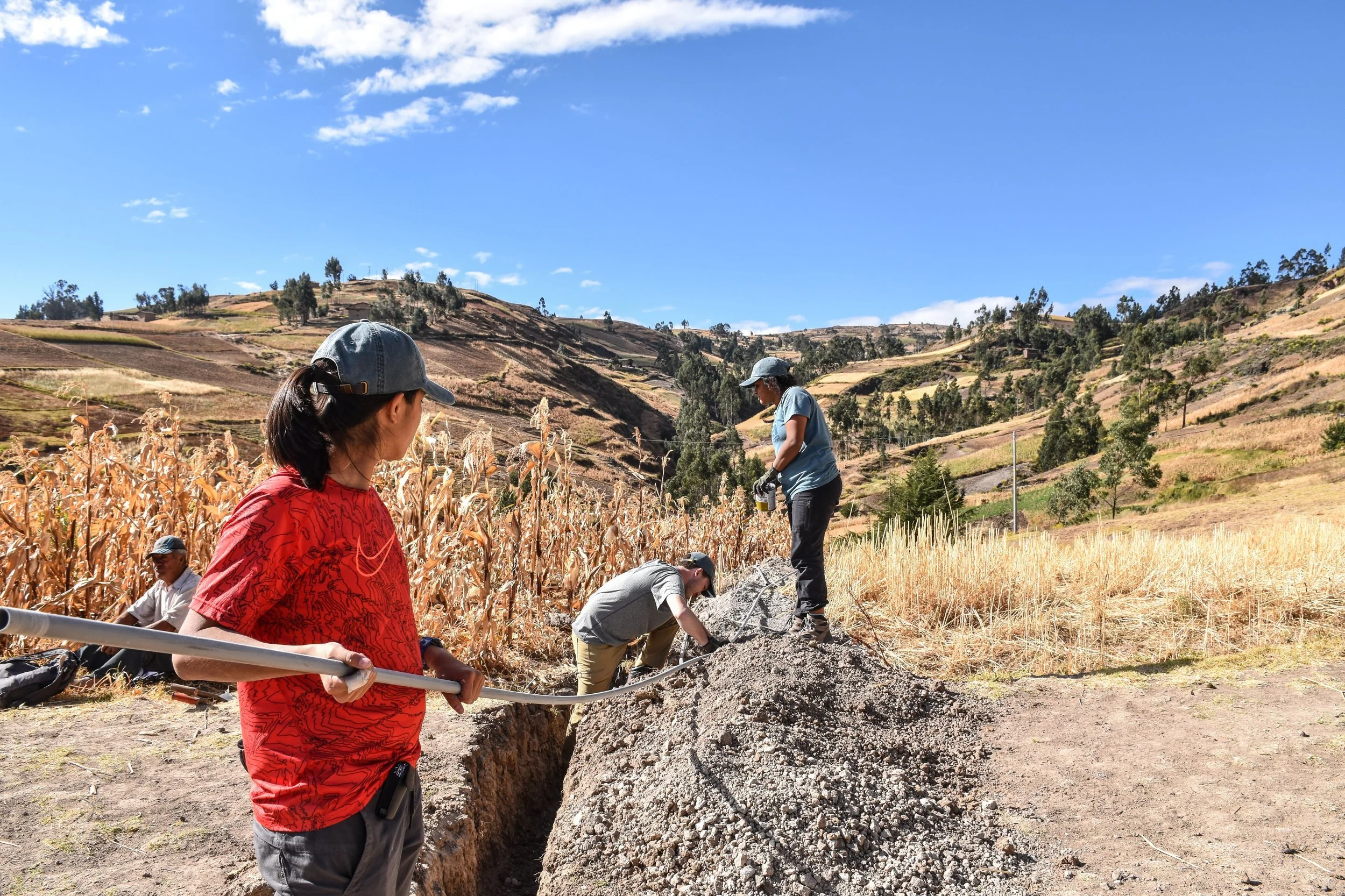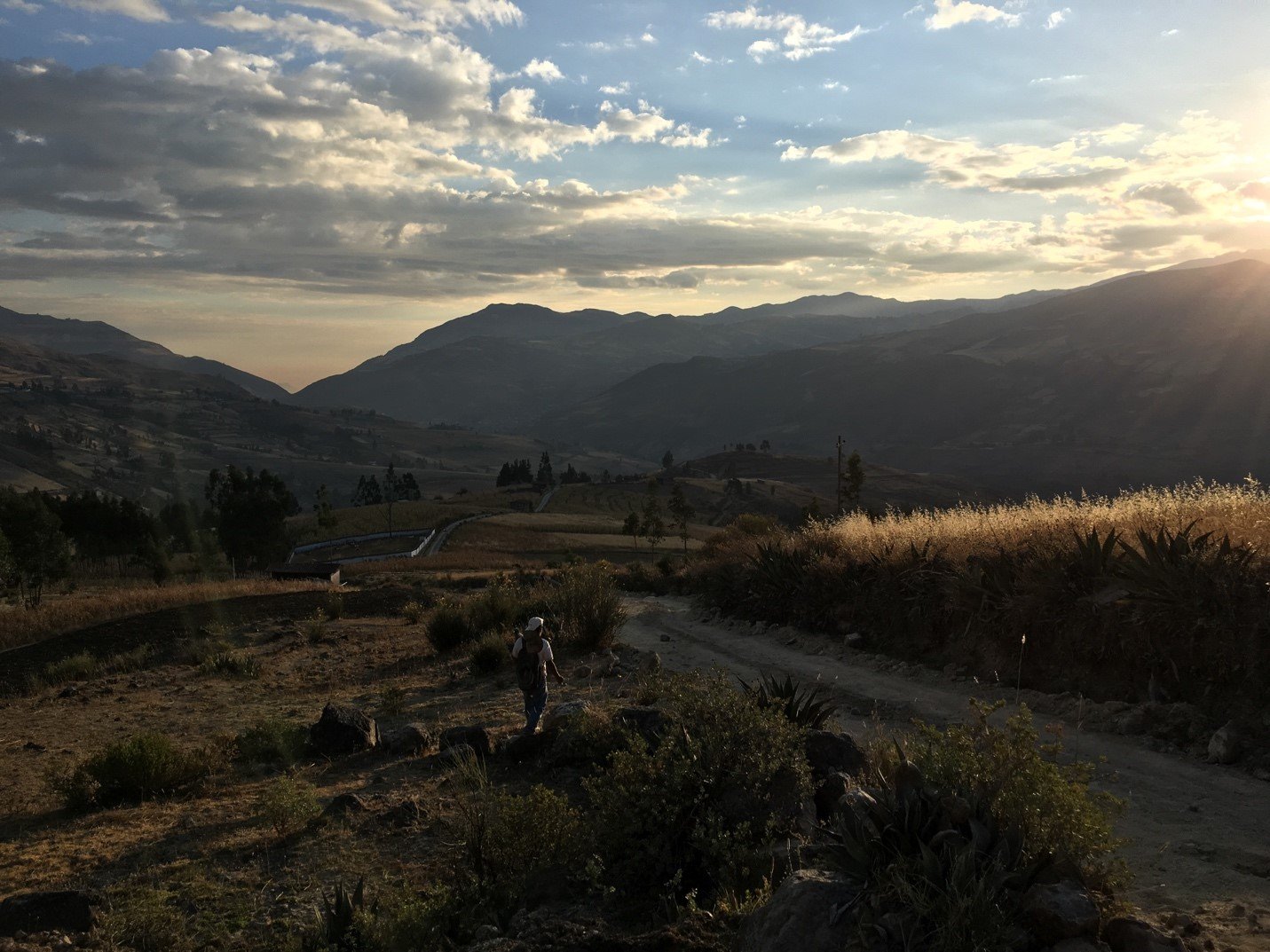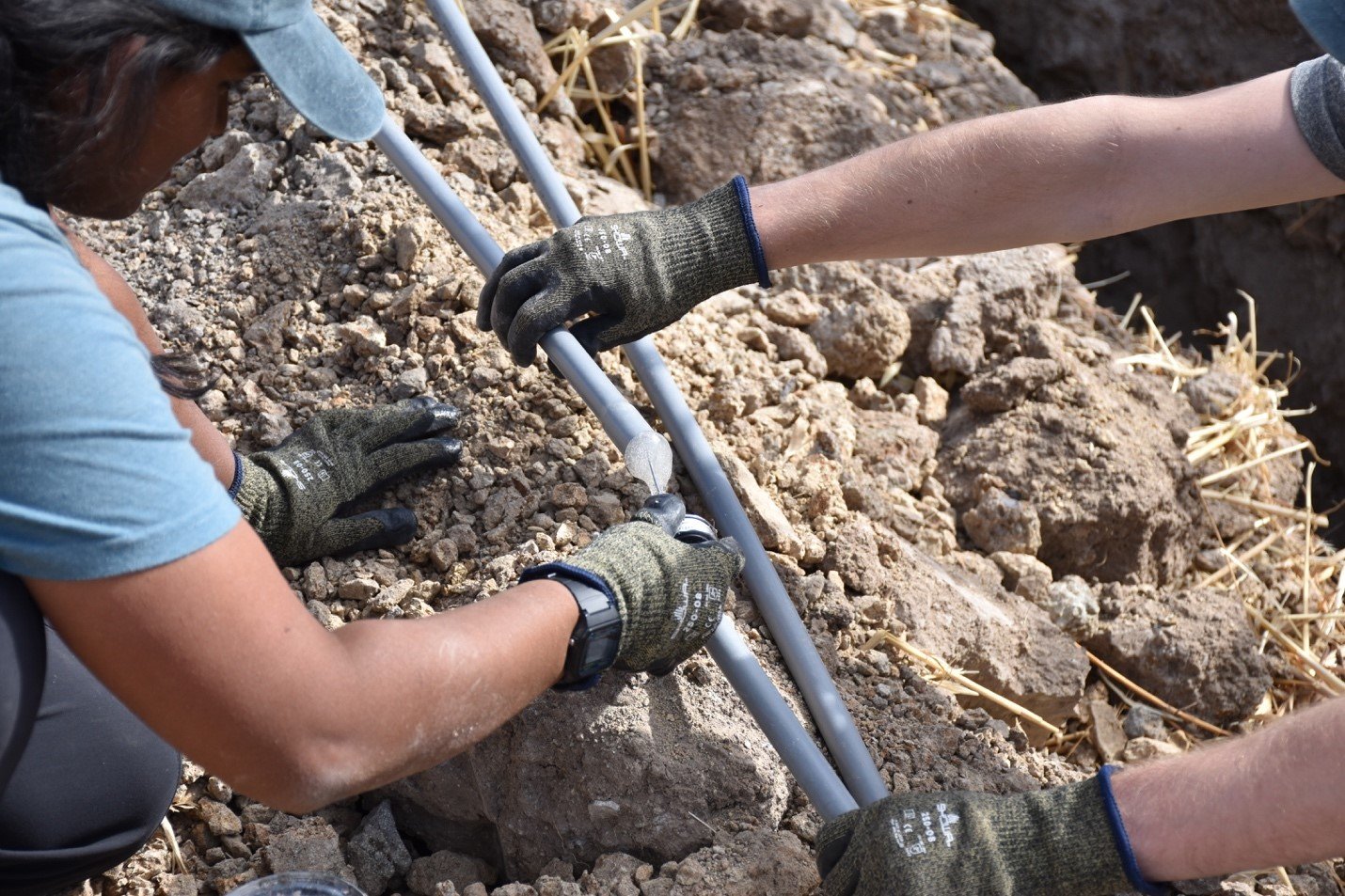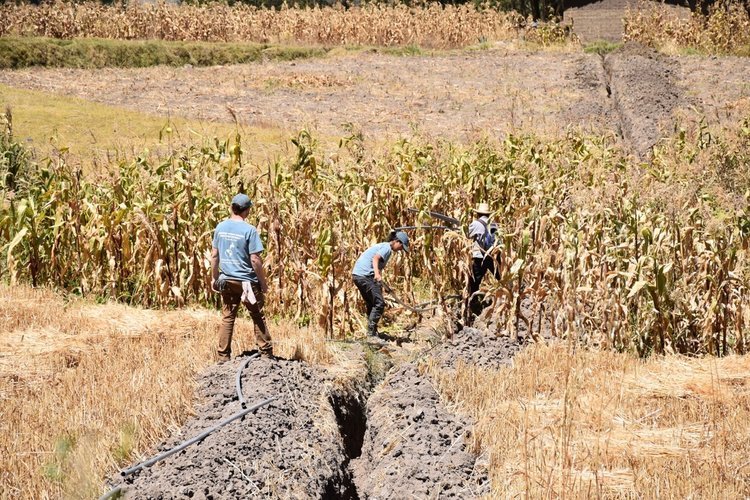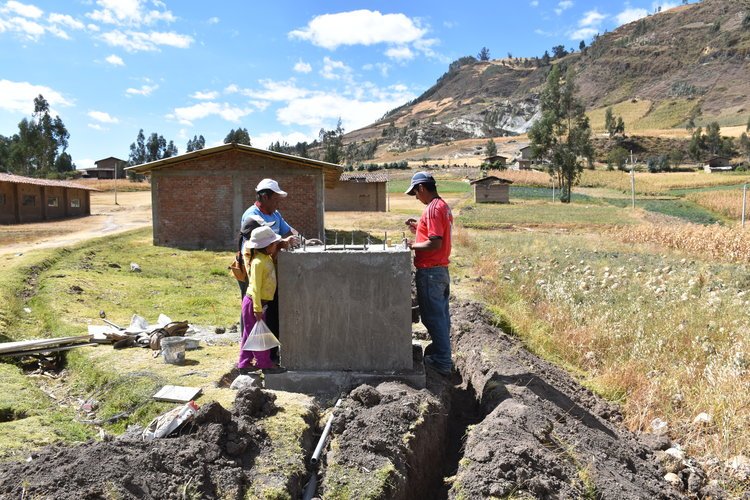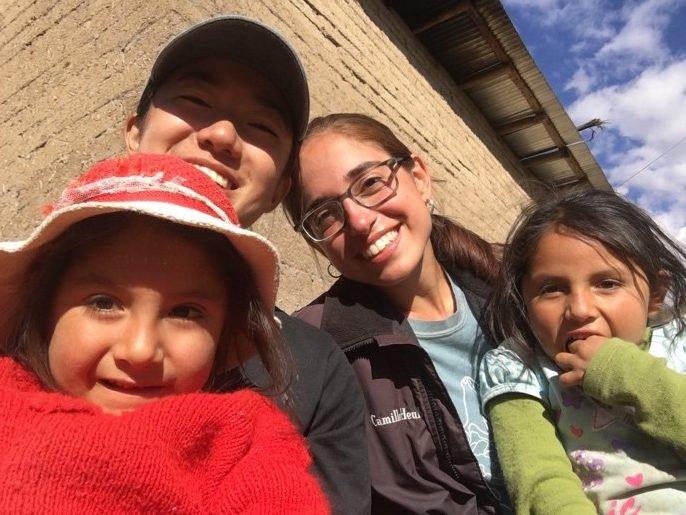Late Nights, More Pipes, and Even More Potatoes
By Sydney Hsu
Potatoes get real old, real fast. Though there is much work yet to be done, it feels as if we’ve already been here for a month. We’ve grown used to defunct Wi-Fi connectivity, sporadic power outages and the constant layers of dust blanketing our clothes and faces. Breathing and walking uphill at 3,000 meters above sea level is not as challenging as it used to be. After spending our first several days orienting ourselves with the mountainous terrain, getting close to community members, and redrawing map lines, we have begun physical construction of the system. I have never been more excited to shovel dirt.
Nicholas and Camille working through the night.
A screenshot from our Google Earth model of the pipeline routes.
The team has high-reaching goals for this summer. We hope to connect the main conduction line coming down from the reservoir to the communities of Ballico, Central, and La Colpa, and install a temporary tapstand at the top of Chimur to service those homes until the system is completely finalized next year. For some numerics: we plan on constructing 6 pressure breaks, 40 tapstands, and connecting 5.6 km of pipeline, bringing potable water to over 200 people in Pusunchás.
Sneha, Nicholas and I laying pipe in the sub-community of Ballico.
The rebar framework of a future pressure break. It was exciting to see progress day-by-day!
Such a large and complicated system is bound to run into obstacles. The language barrier is one—try explaining flow rates and engineering design in a non-native tongue while simultaneously attempting to appear intelligent. There are also many moving parts. As active members of the system, homeowners must dig their own trenches as contribution to the project. We, the engineers, implement the design and oversee construction. Often times, we run into issues with timing (as one can imagine, homeowners get lazy with trenching), land permissions (even the steepest slopes of the mountain are cultivated with crops), geology (cliffs, boulders, ditches, etc.) and even community politics (with Peruvian elections coming up this fall, we’ve already been heckled twice by a political party and a mayoral candidate).
The past two weeks have been physically demanding, to say the least. A few days ago, while trying to connect the first branch of La Colpa line, Camille, Nicholas, Riley and I brought out the pickaxes and shovels, trenching all morning long to find the conduction line buried 80 centimeters in the rock and dirt. According to Riley’s Fitbit data, we’ve been consistently climbing 150-200 floors of stairs every day. And if it weren’t for the abundance of potatoes in the Peruvian diet, I’d say we are burning more calories than consumed. More exciting than the daily chores of digging, sandpapering and carrying 6-meter-long pipes up and down the mountain is connecting the pipelines themselves. Linking pipes to domestic lines going to individual homes can get quite complicated and frustrating with road crossings and tunnels under irrigation channels (Peruvian engineering has its faults, so the irrigation channels will sometimes leak and create more fun for us by filling existing trenches with wet, heavy mud). Pipe geometries can be especially funky. I’ve grown to be quite comfortable with wedging myself into narrow rocky trenches and sawing pipe with a Swiss Army knife to install Ts and 45 degree elbows. After showering twice, PVC glue is still coming off my hands like dry skin. Another common part of our job now as Nicholas enjoyed doing yesterday is sliding down steep gravel while trying to seal two pipes together and avoid knocking all the rocks back inside the trench. It is safe to say we’ve learned a lot about the nature of engineering with all the adjusting we do to fix various problems that arise. But it is a wonderful feeling that every PVC pipe glued, galvanized pipe cut, and T-piece connected means one step closer to delivering potable water to families in Pusunchás. Every day brings progress, poco a poco.
This past week, as we bid adiós to Don, we also welcomed Russ, our tech mentor for the rest of the trip. We are lucky to have a resource as valuable as Russ at this point in the project. Russ came to Pusunchás in 2016 for the first year of the project, so it has been especially helpful to have someone who is already familiar with the area and the ways of the project. We’ve had incredible help from our friends in Pusunchás, including Luciano, Leoncio and Juan who will each trench what four of us did the other day in half the time. Julio hasn’t missed a beat driving us in his truck all day and getting the necessary materials up the mountain from Otuzco. Meanwhile, the mason Tito and his operarios are busy constructing the cement tapstands and pressure breaks under Sofia and Sneha’s careful watch.
Now for some obligatory gastronomical updates. During the unanimously voted best lunch of this trip so far, the team tried some new foods. In addition to the usual corn (choclo), we were introduced to oka, a heavenly root vegetable resembling a potato-ey carrot. For drink that day we shared some chichamorada, which looks like red wine but is really made from dark purple corn juice. Riley liked chichamorada so much that for him it even rivals the street cocktail emoliente (Riley, Sneha, Camille and I had another couple of glasses this week). Turns out we like all things corn. Caña has become a daily snack—sweet cornstalk that you chew and spit out. Every morning, we spread raw honey made from the best bees in Pusunchás on our bread. Breakfast is consumed so quickly we have to go grocery shopping every night. Peruvian chocolate bars are the team weakness—we’re hooked on Sublimes (chocolate with peanuts) and Princesas (dark chocolate peanut butter). I think Scott is why we were out of Sublime Duos. In other news, we’ve discovered a sort of Peruvian pomegranate called granadilla. Its appearance more closely resembles alien fish eggs rather than fruit but it was tasty. We have also established ourselves as the weekly regulars at Don Lucho’s, Villa Andina, and this one pollería that serves us 2.5 chickens and 2 plates of papas fritas. We’ve been eating a lot of chicken lately, and it’s been so long since our last meal of rabbit or cuy that I (almost) miss it. Teresa laughingly could not believe that these animals are pets to Americans and not food, asking Scott: “So what did you do with your guinea pig?”
Riley enjoying some refreshing caña.
The mouth-watering oka root vegetable.
Our days are long (on Friday we worked in Pusunchás before sunrise and after sunset) and so recently after coming back to Otuzco it is straight to bed for the team. Even with our 11-hour workday schedule and a six day work week, we sleep significantly more here than at Princeton. Sofia and Sneha get to enjoy their first real day off work today, a well-deserved Sunday break. As the team recovers from fatigue, illness, inflamed bug bites (Sofia), flea bites (Camille wasn’t supposed to touch the cats), sunburn (hang in there, Nicholas and Scott), and knee injury involving the spiky penca plant (unfortunately I ran right into it), we are enjoying a chill Sunday today to recharge for the upcoming week.
Sofia and I teach Yanira and Deilin how to take a selfie.
Camille and Nicholas with precious weeks-old puppies.
Sunscreen is important!




